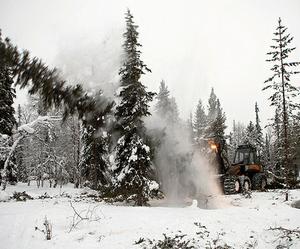 16日發表的聯合國「世界森林狀況報告」(State of the World's Forests)中發現,全球經濟動盪已導致木材需求量的減少,以及林業與林業管理的投資萎縮。
16日發表的聯合國「世界森林狀況報告」(State of the World's Forests)中發現,全球經濟動盪已導致木材需求量的減少,以及林業與林業管理的投資萎縮。
該份報告是每兩年由「聯合國糧農組織」UN Food and Agriculture, FAO)發刊一次,內容建議,為了因應金融危機和氣候變遷造成的雙重挑戰,各界應採取更強硬的林業管理方式,並增加相關科學與技術的投資。
聯合國糧農組織林業部門的專門委員海諾(Jan Heino)表示:「使林業機構適應快速變遷的大環境是一大挑戰。」
經濟衰退可能使政府降低達成綠色目標(green target)的決心,或者在考慮資金預算時,使減緩(mitigation)與適應(adaptation)氣候變遷的重要政策的決議延宕;報告中也針對此一情況表示關切。
依賴國際資金資助,提倡減少伐木和毀林以降低排放的行動,也因此遭遇到阻撓。報告中也警告,主流金融體系的減縮可能使地下金融體系有了擴張的機會,並導致更多非法伐木的情形。「最大的變化莫過於把木頭當作能量來源的情況將急遽增加,尤其是在歐洲,因為政策傾向使用較多的再生能源。」 但在當前的危機中仍有解決問題的機會。
加強關注「綠色發展」(green development)的議題可為森林提供一個的新方向。種植樹木、投資管理永續森林與在實踐綠色建築與再生能源時主動提倡木材的觀念等,這些將成為未來「綠色發展」不可或缺的一部份。
 聯合國糧農組織上週另一份的報告指出,投資永續森林管理可創造出1000萬個綠色工作(green jobs)。海諾表示:「正當許多人因經濟衰退而失去工作,永續森林管理的方式將創造上百萬個綠色工作,如此便可協助減少貧窮與改善環境。因為森林與樹木是儲存碳的重要倉庫,這類投資也為減緩(mitigation)與適應(adaptation)氣候變遷方面的努力作出重大貢獻。」
聯合國糧農組織上週另一份的報告指出,投資永續森林管理可創造出1000萬個綠色工作(green jobs)。海諾表示:「正當許多人因經濟衰退而失去工作,永續森林管理的方式將創造上百萬個綠色工作,如此便可協助減少貧窮與改善環境。因為森林與樹木是儲存碳的重要倉庫,這類投資也為減緩(mitigation)與適應(adaptation)氣候變遷方面的努力作出重大貢獻。」
儘管在拉丁美洲人口的密度不高,也進行回報計畫(report projects),但伐木的速度似乎慢不下來。食物與燃油的價錢居高不下,這代表伐木的情況將持續進行,以滿足豢養牲畜、種植穀物與生產生質能源的需求。
亞太地區在2005年時共計有7.34億英畝的森林,比2000年增加了約300萬英畝。但報告中指出增加的部分是中國高造林率的結果,掩飾在某些國家內大量喪失天然森林的真相。
報告中還警告,氣候變遷正持續威脅森林的健康。在加拿大與美國,由於氣候變遷與成功的火災控制計畫,增加了自然界中易燃物的數量,在長時間乾燥的刺激下,便增強了森林大火的強度與發生的頻率。
The global economic turmoil has resulted in reduced demand for wood, shrinking investments in forest industries and forest management, finds the United Nations "State of the World's Forests" report released Monday.
Stronger forest management and greater investments in science and technology are needed to handle the dual challenges posed by the financial crisis and climate change, advises the report, which is issued by the UN Food and Agriculture Organization once every two years.
"Adapting forestry institutions to rapid changes in the larger environment is a major challenge," says Jan Heino, assistant director-general of FAO's Forestry Department.
The report expresses concern that the economic downturn could lead governments to water down ambitious green targets or defer key policy decisions related to climate change mitigation and adaptation as they focus on bringing in funds.
Initiatives for reducing emissions from deforestation and forest degradation that are dependent on international financial transfers could also face problems.
The report warns that contraction of formal economic sectors can open opportunities for expansion of the informal sector and could lead to more illegal logging.
"The most dramatic change will be the rapid increase in the use of wood as a source of energy, particularly in Europe, as a result of policies promoting greater use of renewable energy," the report states.
But there are also opportunities arising from the current crisis.
Increased attention on "green development" could provide a new direction to the development of the forest sector. Planting trees, increased investments in sustainable forest management, and active promotion of wood in green building practices and renewable energy will all become integral parts of "green development," notes the report.
A separate FAO report last week found that 10 million new green jobs can be created by investing in sustainable forest management. "As more jobs are lost due to the current economic downturn, sustainable forest management could become a means of creating millions of green jobs, thus helping to reduce poverty and improve the environment," said Heino. "Since forests and trees are vital storehouses of carbon, such an investment could also make a major contribution to climate change mitigation and adaptation efforts," said Heino.
The pace of deforestation in Latin America is unlikely to decline in the near future, despite low population density, the report projects. High food and fuel prices will mean continued forest clearance for production of livestock and agricultural crops for food, feed and biofuel.
Asia and the Pacific had 734 million hectares of forest in 2005, about three million hectares more than in 2000. But the report shows that this increase was largely a result of the high afforestation rate in China, masking significant loss of natural forests in a number of countries.
But the report warns that climate change is threatening forest health. The intensity and frequency of forest fires have increased in both Canada and the United States, fueled by prolonged drought attributed to climate change and successful fire control programs that have inadvertently increased the amount of combustible material.



